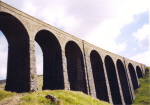Settle-Carlisle Railway
|
|
The Settle–Carlisle Railway (S&C) is a 72 mile (115 km) long main railway line in northern England. It is also known by the terms Settle to Carlisle and Settle and Carlisle, or by a fuller title the Leeds–Skipton–Settle–Carlisle Railway. It is a part of the British railway system and was constructed in the 1870s.
The line runs through a remote region, the Yorkshire Dales, and is considered to be one of the most scenic railways in England.
Due to a combination of the hilly terrain through which it passes, and the fact that it was constructed to main-line standard rather than as a local railway, the S&C was a major trial of engineering. It contains 14 tunnels and 17 viaducts, the most notable being the Ribblehead Viaduct.
The line runs from near the town of Settle, beginning at a junction with the line from Leeds to Morecambe, extending to the town of Carlisle on the England/Scotland border. On the way the line passes through the town of Appleby and a number of small communities.
21_Ribblehead_Station_Wiki.jpg
| Contents |
History
The S&C was built by the Midland Railway company, after an dispute with the London and North Western Railway over access to Scotland over the LNWR's route.
Construction work started in 1870, and was completed in 1876. It was not a branch line, but was engineered to express standards throughout.
After nearly a century of uneventful existence in the 1960s, as a part of the Beeching Axe the S&C had many of its minor stations closed in 1970 and its stopping passenger service cut to just two a day, leaving only freight and a handful of passenger services operating on the line. The main Expresses, 'The Waverley' from London to Edinburgh via Nottingham ended in 1964, while the 'Thames-Clyde Express,' from London to Glasgow via Leicester, lasted until 1974.
From the 1960s until the 1980s the S&C suffered a drought of investment, and much freight traffic was diverted from the S&C onto the West Coast Main Line. Because of the lack of investment the condition of many of the viaducts and tunnels on the line was deteriorating.
Threat of closure
In the early 1980s, the S&C was carrying only a handful of trains per day, and British Rail decided that the cost of renewing the viaducts and tunnels would be prohibitively expensive, given the small amount of traffic carried on the line.
In 1984 closure notices were posted at the S&C's remaining stations. However, local authorities and rail enthusiasts joined together and started a campaign to save the S&C, pointing out that British Rail was ignoring the S&C's potential for tourism. The campaign uncovered convincing evidence that British Railways had mounted a dirty tricks campaign against the line, exaggerating the cost of repairs and deliberately diverting traffic from the line in order to justify its closure plans.
British Rail eventually agreed to keep the line open in 1989, and to repair the deteriorating tunnels and viaducts.
The line today
In recent years, due to congestion on the West Coast Main Line, much freight traffic is using the S&C once again, and local passenger traffic has increased with many of the minor stations re-opened; in addition, the line has become an important diversionary route from the West Coast Main Line during engineering works.
The S&C is probably busier now (2005) than at any time in its history.
The route of the line is described more fully in the Airedale Line article.
External links
- Settle - Carlisle Partnership (http://www.settle-carlisle.co.uk/)

